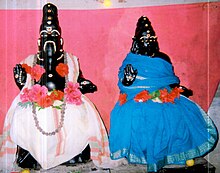 |
Agastya needed to marry and sire a son, in order to fulfill his
duties to the Manus. Once he resolved upon doing this, Agastya pursued
an unusual course of action: by his yogic powers, he created a female
infant who possessed all the special qualities of character and
personality that would be appropriate in the wife of a renunciate. At
this time, the noble and virtuous king of Vidarbha
(an area in south-central India, just south of the Vindhya mountains),
was childless and was undertaking penances and offering prayers to the
divinities for the gift of a child. Having come to know the plight of
the king, Agastya arranged for the transformation of the child he had
created, to be born the daughter of that noble king of Vidarbha. The
child thus born was named "Lopamudra"
by her parents. Upon her attaining marriageable age, Agastya approached
the king and sought the hand of his daughter. The king was initially
chagrined to hear such a suggestion from a renunciate, but found that
his daughter, who had already exhibited extraordinary standards of mind
and character, was insistent that he should accept the proposal. She was
utterly intent upon renouncing the royal palace of her father and set
out to live in forest at the hermitage of Agastya. Lopamudra and Agastya
were duly married and lived a life of extraordinary felicity and
happiness. It is believed that they had two sons - Bhringi &
Achutha. In Mahabharata (Vana Parva: Tirtha-yatra Parva), there is mention of his penance at Gangadwara (Haridwar),in Uttar Khand State in India, with the help of his wife, Lopamudra (the princess of Vidharba).
Lopamudra attained the rank of one of Mahapativrathas in the world by
her dedication to worship her husband Agastya, and remained with other
Pathivrathas (Noble exalted wives),like Mandodari (Ravana's wife),etc.

No comments:
Post a Comment